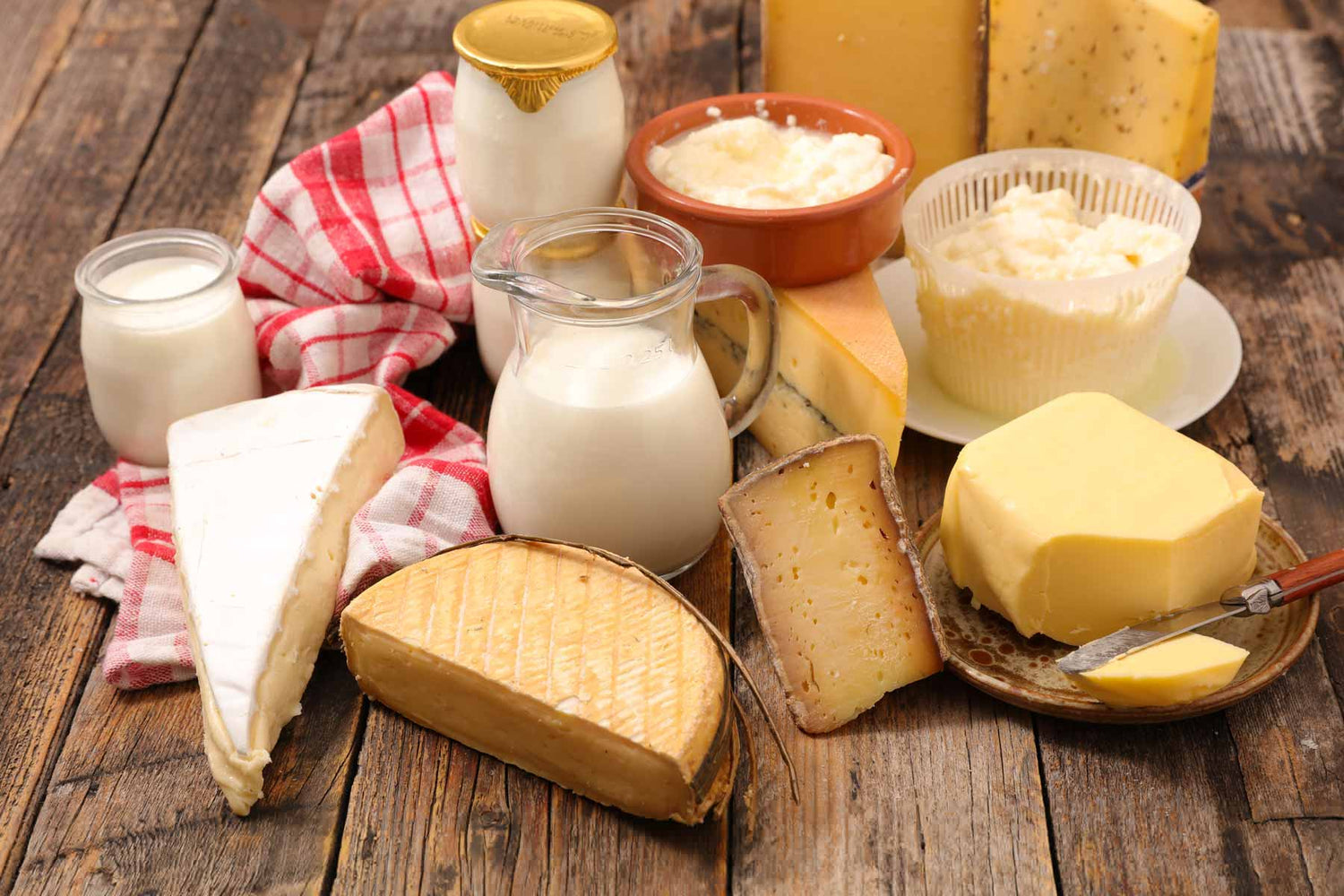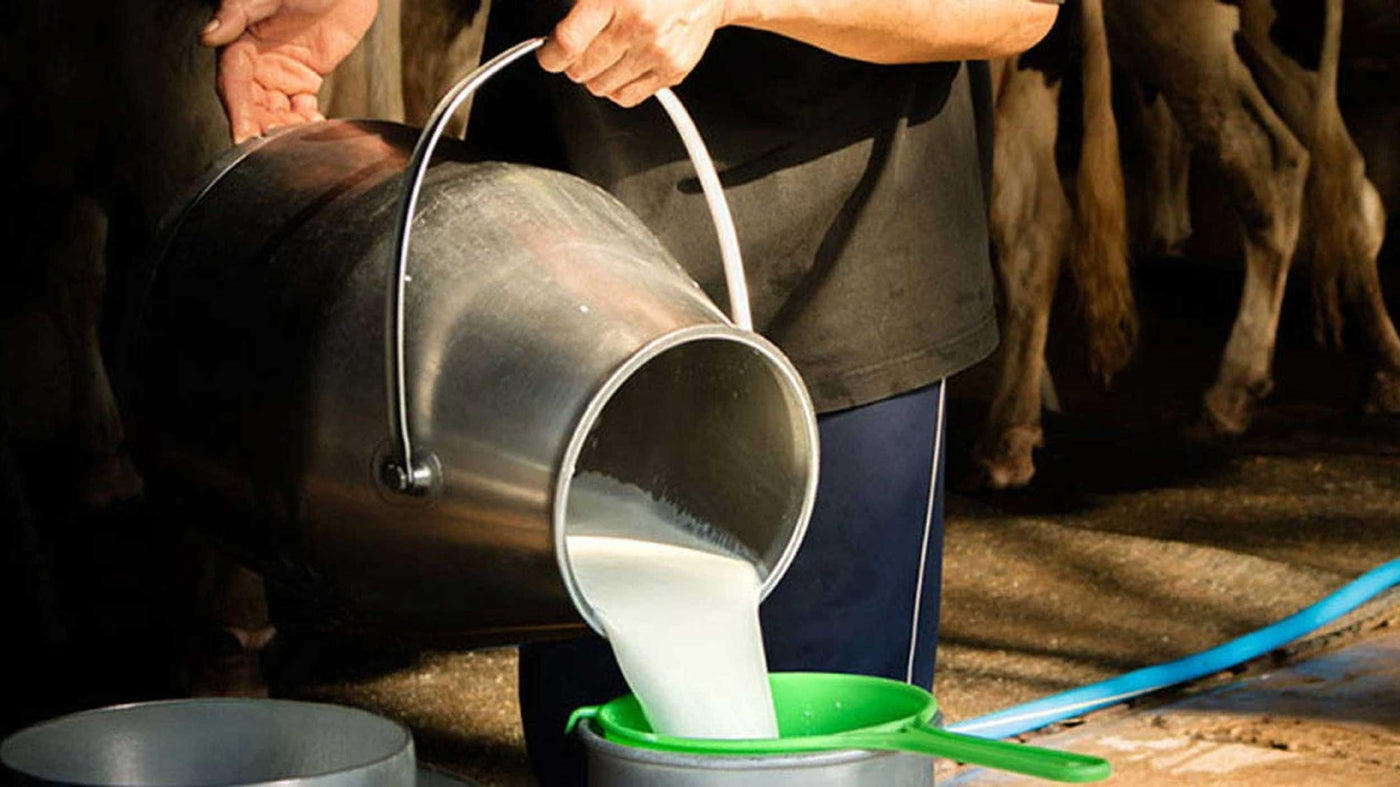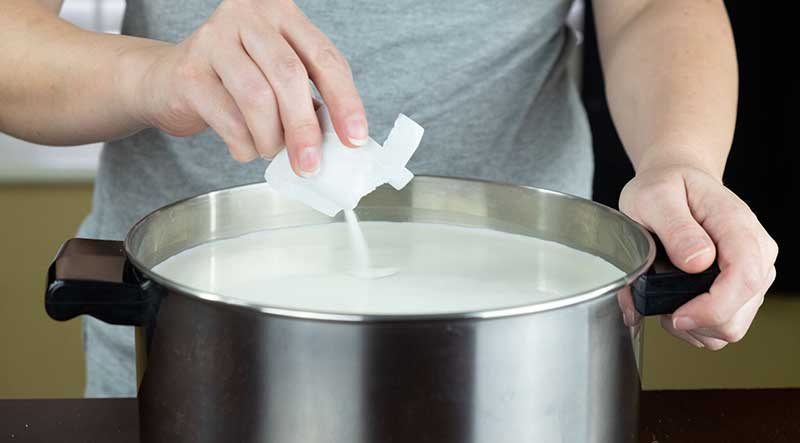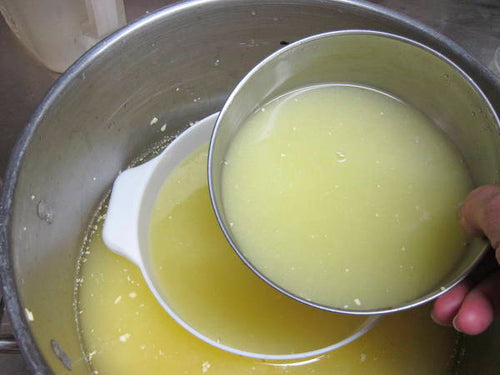When trying to find good milk for cheese making there are a few things to consider and sometimes it can be tricky to know where to begin.
That's why we're sharing some tips and suggestions, including information on pasteurized milk, raw milk, how milk is processed, checklists to help you along the whey and much more.
When you're ready to find good milk near you we also have a Good Milk List to help you find milk locally. This resource is created by happy cheese makers who share their favorite milk sources around the world.
Why and when did people start drinking milk?
When stored, fresh milk begins to spoil and change almost immediately due to its high nutrient value and the millions of small microbes that would like nothing more than to consume it. Finding a way to store and preserve milk is where to story of cheese making first began, a long long time ago.
For thousands of years milk was solely consumed by young mammals until they were able to eat and digest solid foods. This was true until humans began domesticating and taming milk producing mammals, at least tame enough to not kick or run while they were milked. This transition is where hunters/gatherers started to become agrarians and settle down in one place for longer periods of time.
At first the milk was for drinking and perhaps cooking but extra milk would go bad quickly, if not consumed by animals or the human community.
At some point over time humans discovered that soured milk was not always bad and they began consuming a simple lactic coagulation, milk coagulated with natural present cultures. The milk would naturally develop enough acidity to coagulate on its own. These curds were then strained and separated from the whey, and perhaps consolidated and dried. This turned the milk into a somewhat preserved source of proper nutrition for humans to consume over longer periods of time.
Eventually humans found through experimentation or just plain accident that some things, when added to milk, made it form a smooth curd that was now firmer when curdling. This could have been from adding herbs and flower parts such as thistle or even cutting a fig branch for stirring the milk. We still see this being done today traditionally and with Thistle Rennet.
At some point humans also discovered the stomach of a young mammal had magical powers to form a curd that could be consolidated even more. This curd could be pressed and dried for longer storage and higher quality. This reaction was due to the enzyme chymosin which makes up the largest portion of modern day Rennet.
In most cultures cheese is ever present today and can be tracked through history to see how the process evolved over time.
Can milk quality affect cheese making?
Yes, the quality and type fo milk can affect cheese making, in both good ways and bad.
Many people believe that milk is never changing and always stays the same, in actuality this couldn’t be further from the truth.
If you make cheese with raw milk you may have come to this conclusion on your own. You may have noticed the same type of cheese made with the same type of rennet, cultures and milk can vary drastically from batch to batch, season to season, year to year, etc.
This is because the exact same milk is not definitely not the same from day to day, season to season or year to year.
Many cheese making issues can be attributed to the milk being used, and often times something that has changed in the milk or the environment over time.
In addition to changes in the milk, there are also certain types of milk that make outstanding cheese, types that are good for cheese making, ok for cheese making and some that won’t make proper cheese.
Is all milk the same, no matter what?
No, each each type of animal produces their own unique milk with different components and nutrients. This means goat, sheep, cow, water buffalo… each produce a slightly different type/quality of milk.
Each breed, within the same group of animals, will also produce a slightly different type/quality of milk, for example Jersey vs Holstein.
Care and treatment of animals affects the quality of their milk
- Location | The same type and breed of animal in different locations will produce slightly different milk
- Seasons | Changes in the season will produce differences in milk solids
- Diet | Pastures and feed will affect milk
- Exercise | The amount of exercise an animal gets will change the milk
- Handling | Free range pasture vs large scale commercial farming affects the quality of milk
- Time | How long the animals are milked before being dried off and freshened affects the quality of milk
- Milk Treatment | Pasteurized vs raw milk affects the quality of milk
- Animal Care | Even disposition and care of the animals such as well cared for happy cows vs large high production herds affects the quality of milk
Handling affects the quality of milk
- How Animals Are Milked | Use of automated milking equipment or milked by hand
- Properly Chilling Milk | Milk needs to be chilled properly and quickly
- Transportation | Milk can be trucked long distances to the processing plant or picked up Fresh from the farm
- Storing Milk | Sometimes milk is held for long periods in storage tanks
- Processed or Not | Milk can be raw or pasteurized
- Type of Processing | Different amounts of heat and time can be used during the Pasteurization process
- Long Term Storage | Sometimes milk sits on the store shelf for long periods of time
Overall the milk you source can and will affect the quality of your cheese. With all this information, let’s now talk about ways to select and source good milk for cheese making.
Good quality, pasteurized milk is the best choice for beginner cheese makers
Lots of fantastic cheese is made with good quality pasteurized milk.
Good quality, pasteurized milk is by far the easiest milk for beginner cheese makers to work with. When youre exploring different types of cheese to make, consider the unique characteristics of washed rind cheeses, which have a fascinating history tied to the cheese-making practices of European monks. Their traditional methods have contributed to the distinctive flavors and textures that cheese enthusiasts cherish today. This milk is typically processed on a large scale with many herds and sources combined together. When different sources of milk are all blended together to a standard the processing location will have specific criteria for the farms to follow in regards to their milk. Because there is so much variety it ends up balancing out a lot of the variables found in milk.
When it comes into the processing facility cream is separated from the milk and stored separately. When it's time for processing, pasteurization and homogenization, the milk and cream are standardized to 1% 2% or 3.25% butterfat. Any excess cream is saved and later used for butter or other products requiring cream.
Why does milk get pasteurized?
For centuries people have enjoyed fresh un-pasteurized milk from a healthy animals. However, if the animal has health issues or the milk is handled poorly the milk becomes unsuitable for human consumption.
Milk can meet all of the nutritional needs of a newborn. But, it is also perfect for many non-dairy bacteria that can populate milk quickly if it’s not properly cared for. This can lead to some major health risks when drinking raw milk.
Traditionally, before pasteurization, the procedure was to milk animals daily and consume their milk quickly, because natural bacteria, as well as the un-invited ones, can grow quickly if left at room temperature and some can even grow at fridge temperatures. This natural fermentation is often referred to as clabbered milk, when it begins to coagulate on its own.
When farms were small and milk was consumed quickly there were very few problems. As populations and demand for milk in non-rural areas increased health issues increased.
Over time larger populations grew and herd sizes had to grow in order to keep up with demand. Larger herds often made it more difficult to maintain sanitation standards. Milk borne diseases began to rise as herds became larger and the supply chain became longer and longer. This is when the scientist Louis Pasteur stepped in with his pasteurization process.
By the early to mid 20th century, much of our milk was being pasteurized due to milk causing health issues. With pasteurization and better standards of sanitation, large scale milk distribution quickly became safer.
Today, milk could not travel and sit in a store for the period of time it does without pasteurization.
How does milk get pasteurized?
During pasteurization milk is heated to at least 162F for 16-20 seconds in larger dairies or 145F for 30 minutes for small farms before chilling.
Higher temperature methods also exist, some dairies go beyond 168F, but this can sometimes be problematic for developing a good curd when making cheese. If your curd breaks into small grains when you try to cut or stir it this is a likely caused by overheated milk.
The final pasteurized milk is not sterile but has had most of the pathogenic bacteria removed through heat treatment. The downside of pasteurizing is that it destroys some of the beneficial enzymes as well as the good dairy bacteria and can change the overall flavor significantly.
Why does milk get homogenized?
In addition to Pasteurization, bottling facilities also tend to Homogenize the milk. This process prevents cream from rising while bottled milk is transported and placed on a store shelf.
Homogenization shatters and breaks larger fat globules into smaller sizes. This is not normally a problem for cheese making except when the cheese has a longer aging period.
This process can actually make the cheese making process a little easier because it eliminates having to deal with cream as it rises and separates in the cheese vat. It also prevents you from having to deal with varying amounts of butterfat, which means you won’t have to make process changes to compensate.
The downside of homogenization is that the butterfat surface is changed and can become a problem with long term aging of higher fat milks made into cheese.
Cold stored milk can loose calcium which may affect cheese making
A concern with long stored milk is that during the cold storage journey some of the calcium is lost. This can affect the cheese making process because calcium is needed to bind the curd disassociates, and this lack of calcium can result in a weak curd. The good news is this deficiency can be largely correct by adding about 1/4 tsp of Calcium Chloride solution for every gallon of milk when making cheese.
What are the differences between milk quality and milk economics?
Many large and small scale dairies today are faced with the hard job of balancing the scales between quality and economics when it comes to milk.
For us cheese makers, this can mean the difference between milk with the potential for a great cheese and milk that is difficult to produce a good cheese from.
However, the right choice is not always black and white, raw vs pasteurized, because there are many world award winning cheeses made with pasteurized milk and many low quality cheeses made from improperly sourced and stored raw milk.
Milk Quality
- Smaller farms and herds
- Quality of milk over quantity
- Pasture raised
- Low pasteurization temperature
- Local
- Fresh
Milk Economics
- Large scale production
- High density enclosures
- Diets for yield over quality
- Competing for a lower priced product
- High yield animals, sub-standard quality milk
- High heat pasteurization
- Long distance distribution
- Shelf stable for extended period of time
How to find the right milk for cheese making
When looking for good milk the first decision is often based on how much you want to pay for milk vs the quality of the final cheese. Finding the right milk in your area for cheese making is well worth the effort because the result will be a high quality cheese you can enjoy time and time again.
You can find the perfect milk, that is both economic and high quality, by first deciding which qualities are most important to you.
Good milk for cheese making checklist
- Good Flavor | Source a milk that has the best flavor to start with
- Right Cost | Milk that you can comfortably afford for your cheese making
- Avoid | Ultra-pasteurized and high temp pasteurization milk, anything above 168F
- Processing | 162F held for 16-20 seconds or lower temp is a good choice for cheese making
- Expiration Date | Avoid milk that is close to the best before date
- Keep it Simple | Try making a simple cheese from several milks before making cheese that needs longer aging, this will help you find a good quality milk more quickly
- Good Milk List | Visit our Good Milk List for a collection of good milks for cheese making. This is a resource built by happy cheese makers, filled with milk they have worked with successfully over the years
Why is raw milk sold differently than pasteurized milk?
Now that we’ve covered pasteurized milk lets talk about raw milk. If you’re interested in cheesemaking you’ve most likely heard a lot about raw milk. However, it may have been in the context of ‘Raw milk is good’ or ‘Raw milk is bad.’
Talking about raw milk is often times polarized to the extremes which can make it difficult to truly learn about the pros and cons.
Let's stop and take a moment to consider the fact that a young lamb, kid, or calf gets it straight from the source with no processing and seems to have no concerns with raw milk. But, perhaps this is because little ones drink milk on demand, as opposed to humans storing and drinking raw milk from other animals. With the extra handling and storage there is more room for something to go wrong.
Here’s the path bottled milk takes on its way to you
- First it goes directly from the udder into automated milking equipment and pipelines
- It gets chilled along the way
- Once chilled it’s added to previously chilled milk
- A big truck comes and trucks it to the bottling location
- It’s usually stored for a few days
- Next it gets processed into retail packaging
- And it goes back into another truck
- Then it travels to a store where it sits for a period of time.
- Finally the milk is purchased
With so many steps and so much time there are a lot of opportunities for things to go wrong with the milk. However, thanks to hard working facilities, sorting the retail milk chain out with better sanitation, pasteurization, and cold storage milk is safe and available on a large scale.
Imagine if raw milk was taken on this same path, followed the same steps and needed to be stored for the same amount of time. Would it work, would it be safe?
Our opinion on raw milk is that it’s one of the best ways to consume dairy, if you can get it locally to eliminate this commercialized path most milk takes.
Here’s a good path for raw milk
- First it goes directly from the udder into automated milking equipment and pipelines
- It gets chilled along the way
- Then it goes directly from the farm to the consumer
This shorter production chain helps provide high quality, safer milk that is fantastic for cheese making.
Is raw milk safe for cheese making?
Only you can make the decision to use raw milk and you will need to do your own evaluations and research.
To start with raw milk is still illegal to sell in some parts of America and other countries too. Big brother is looking out for our well being, or so they say. Maybe they just want to avoid any remote chance of a raw milk incident coming back on them. Either way this outlook is slowly changing because of consumers calling for raw milk to become more easily available.
Prior to the introduction of pasteurization in the early to mid-1900’s, all milk was consumed raw in its natural, unprocessed state.
And today in parts of Europe there are locations where you can walk up to a raw milk dispensing machine, insert your Euro and walk away with a Liter of raw milk, no questions, no supervision.
Pros for raw milk
- Raw milk tastes better
- It provides better curd formation
- Your Raw milk is intact with everything from the pasture that nature provided
- It contains natural bios, in many cases a healthy dairy blend that has sorted itself out over generations
- Raw milk contains beneficial dairy bacteria and enzymes to make cheese easier to digest
- Omega3 is higher in raw milk providing many health benefits, especially in pasture raised animals
Cons for raw milk
- It doesn’t travel or store well
- Raw milk has the potential to introduce milk borne disease and health risks
- It has the potential to cause problems for those charged with a nations health
- The potential for contamination begins with the udder, skin, feces, milking equipment, handling and storage, so proper sanitation and milk handling is imperative
Things to keep in mind when purchasing raw milk
Our overall recommendation is that raw milk should be sourced direct from the farm as close to milking as possible. Transporting and storing cold can open the door for undesirable activity in the milk. We feel raw milk is best when used for cheese making within about 2-3 days. After this time the protein changes can begin to show a weaker curd development.
Raw milk naturally has its own collection of bacteria and enzymes that begin working as soon as conditions are right. Some of these can even start developing at fridge temperatures. So as soon as raw milk leaves the udder enzymes begin to reduce the protein structure and bacteria begin to multiply and convert lactose to lactic acid. On most farms that have been milking for years, many of these bacteria have established themselves as good dairy bacteria.
A good thing to remember, before we had access to lab prepared cultures, all cheese makers relied on these natural dairy bacteria to make their cheese. Today it is still possible to make your own cultures from raw milk but, it’s a lot of work to safely prepare and and keep them going. A lot of trials are needed to sort out the gas producers as well as any off flavors or smells and of course the milk needs to start out clean.
Checklist when searching for raw milk
- If you have local farmers markets where cheese is being sold, talk with the vendors about where to find raw milk.
- Use our Good Milk List to find high quality milk sources near you.
- Ask friends if they know of anyone who is milking their own animals and selling raw milk.
- Visit the farm to see the animals, how the milking goes and talk to the owners. Sanitation and care of the animals is very important.
- Form your own opinion of the operation and milk and be sure you feel comfortable with the milk source.
- Once you have found raw milk start with small trials, if you have never consumed raw milk you may digest it differently.
- If you have an uncomfortable reaction that persists stop using raw milk and consult your doctor
- Avoid any milk that is more than three days old and any milk that does not taste or smell good.
We hope this will help you make decisions on the milk you want to use in your cheese making.
If we missed anything you'd like to see added, please send us an email at info@cheesemaking.com.












































































































































